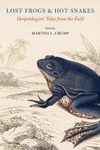Monograph Journal / Magazine
Out of Print
By: Charles W Myers(Author), Maureen A Donnelly(Author)
147 pages, 80 colour & b/w photos and b/w line drawings, 1 b/w map, 10 tables
![The Summit Herpetofauna of Auyantepui, Venezuela The Summit Herpetofauna of Auyantepui, Venezuela]()
Click to have a closer look
About this book
Related titles
About this book
Language: English with bilingual summary in English and Spanish
Auyantepui is an immense sandstone table mountain in the Venezuelan Guayana. This mesa did not appear on aviation maps and was unknown to the literate world prior to the late 1930s. It was explored from the air by Jimmy Angel, a bush pilot and colorful soldier of fortune for whom the world's highest waterfall is named (Angel Falls at the northern end of Auyantepui). About the same time, in 1937, Captain Félix Cardona Puig and Gustavo Heny discovered an access crack in the sandstone, allowing ascent onto the southern end of the mesa. The first scientific exploration followed immediately – the 1937–1938 Phelps Venezuelan Expedition of the American Museum of Natural History made the first zoological and general botanical collections. Today, no tepui other than the “Lost World” of Cerro Roraima is better known to the general public.
The summit of Auyantepui has a known fauna of 24 species of amphibians and reptiles, including species added by the Robert G. Goelet American Museum–Terramar Expedition in 1994. This expedition collected 16 species during a month of fieldwork in the dry season (February), in five camps at elevations of 1 700–2 100 m above sea level. All species known from the summit of Auyantepui are treated in this bulletin; illustrations where possible include tadpoles, bioacoustic spectrograms, and hemipenes.
Four new species are described – two frogs (Hypsiboas angelicus, n. sp., Eleutherodactylus auricarens, n. sp.), a lizard (Arthrosaura montigena, n. sp.), and a snake (Atractus guerreroi, n. sp.). Arthrosaura montigena possesses a hemipenial character not previously described – an orifice (orificium) of unknown function, situated in the lobular crotch between the two lobes. Attention is called to a probably undescribed snake (Liophis “miliaris” sensu lato) from the nearby Gran Sabana.
The herpetofauna of the Auyán summit comprises 12 families, 20 genera, and 24 species. This is compared with the known herpetofauna of the Chimantá massif, lying less than 50 km south-southeast of Auyantepui. Despite the proximity and similar dimensions, the summits of Auyantepui and Chimantá have in common only 11% of the combined number of species (4 of 36), 44% of the genera (11 of 25), and 62% of the families represented (8 of 13), showing that neighboring tepuis may have herpetofaunas very different from one another. Nonetheless, the adjacent mountains that constitute the more fragmented Chimantá massif are relatively close to one another and seem to have a unified herpetofauna.
Customer Reviews
Monograph Journal / Magazine
Out of Print
By: Charles W Myers(Author), Maureen A Donnelly(Author)
147 pages, 80 colour & b/w photos and b/w line drawings, 1 b/w map, 10 tables














































